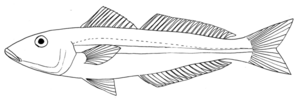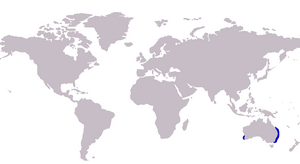Stout whiting facts for kids
Quick facts for kids Stout whiting |
|
|---|---|
 |
|
| Scientific classification | |
 |
|
| Range of the stout whiting |
The stout whiting (Sillago robusta) is a type of smelt-whiting fish. It is also known as the yellow-cheek whiting or school whiting. This fish lives on the bottom of the ocean, in sandy areas.
Stout whitings are long and a bit flat, growing up to 30 centimeters (about 12 inches) long. They are only found in Australia. There are two main groups: one lives off the western coast, from Shark Bay to Fremantle. The other lives off the eastern coast, from Bustard Head in Queensland to northern New South Wales.
These fish live in deep, sandy parts of the continental shelf, sometimes as deep as 70 meters (230 feet). They are carnivores, meaning they eat other animals. Their diet includes different kinds of worms and small crustaceans.
Stout whitings grow quickly. They can start having babies when they are about 13 centimeters long. They usually lay their eggs between December and March. Young fish from the eastern group move to safe, shallow waters near the coast. However, young fish from the western group stay in deeper waters their whole lives.
Stout whitings are very important for fishing, especially in southern Queensland. Most of the fish caught are frozen and sent to countries in Asia. Some are sold in Australia too. This fishing business is worth about 3 million Australian dollars each year.
Contents
About the Stout Whiting
The stout whiting belongs to a group of fish called Sillago. This group is part of the smelt-whiting family, called Sillaginidae. There are 29 different types of fish in the Sillago group.
Scientists first officially described the stout whiting in 1908. They used a fish found in Rose Bay, New South Wales, to name and describe the species. Another scientist later described the same fish in 1910, giving it a different name, Sillago auricomis. But the first name given by Stead in 1908 is the one that is still used today.
In 1985, a scientist named Roland McKay studied these fish closely. He noticed small differences between the eastern and western groups of stout whitings. These differences were in their fins and a special organ called a swim bladder. He thought the two groups might have become separated during the last ice age. At that time, a land bridge might have blocked the Torres Strait, stopping the fish from moving between the two areas.
The most common name for this fish is 'stout whiting'. It is also sometimes called 'yellow-cheek whiting' or 'school whiting'. 'School whiting' is a general name used for several types of whiting fish in Australia.
What the Stout Whiting Looks Like
The stout whiting looks a lot like other whiting fish found in Australia. The best ways to tell them apart are by looking at their dorsal fins and their swim bladders.
It is a small fish, usually less than 23 centimeters (9 inches) long, but it can grow up to 30 centimeters. Like most whiting fish, its back is a bit more curved than its belly. This shape helps it live on the ocean floor.
The dorsal fin, which is on its back, has two parts. The first part has 11 stiff spines. The second part has 1 spine and 16 to 18 soft rays. Bigger fish have a clear ridge on the first spine of their first dorsal fin. This ridge is even more noticeable in the eastern group of fish. The anal fin, on its belly, has 2 spines and 16 to 19 soft rays.
The stout whiting has 65 to 70 scales along its lateral line, which is a line of special scales along its side. Its cheeks have 2 to 3 rows of scales. In total, it has 33 bones in its backbone, called vertebrae. The swim bladders of the two groups of fish are slightly different. The eastern group has small parts sticking out at the front sides of their swim bladder, but the western group does not.
When alive, the stout whiting is creamy yellow to sandy pink on its back. Its belly is silvery white with a hint of purple. A silvery band often separates these two colors along its side, but it can be hard to see. The fish's body and fins do not have any dark spots. The only splashes of color are yellow patches on its cheeks and a yellow spot at the base of its first dorsal fin.
The first dorsal fin is white at the bottom and darker towards the top. The anal fin is white, becoming more yellow at its base. The tail fin is a pale lemon yellow with speckled edges. The fins on its belly are white, and the fins on its sides are clear. Sometimes, the color of the fish can vary depending on where it lives, especially in Shark Bay. Fish from Shark Bay might have faint gold bars and black dust-like markings on their dorsal and anal fins.
Where Stout Whitings Live
Stout whitings are found only in Australia. They live in two separate areas: one along the eastern coast and one along the western coast.
The eastern group lives in a wider area, from Bustard Head in Queensland down to southern New South Wales. The western group lives from Shark Bay in the north to Fremantle in the south.
Stout whitings live in deeper waters than other Australian whiting fish. They prefer sandy areas at depths of 10 to 70 meters (33 to 230 feet). Young fish from the eastern group live in shallower waters for their first year, often in large bays and near surf beaches. However, the western group of fish stays in deeper waters their entire lives.
In northern Australia, another fish called the mud whiting lives in similar deep offshore areas. In southern Queensland, stout whitings live in deeper waters alongside another type of whiting, S. flindersi. Here, stout whitings prefer deep sandy areas that are influenced by rivers.
Life Cycle and Habits
Because stout whitings are so important for fishing, many studies have been done on them. These studies look at how they grow and how they have babies, especially in southern Queensland. Other studies in Western Australia focus on what they eat and how they move.
Like most smelt-whitings, stout whitings live in schools, meaning they swim together in groups. They sometimes swim with other whiting species. They are thought to form large schools mainly at dawn and dusk.
What They Eat
Stout whitings are predators that live on the ocean floor. They use their mouths to suck up prey from the sand. Studies in southern Queensland show that they mostly eat small crustaceans and polychaete worms.
Smaller stout whitings, less than 10 centimeters long, mostly eat tiny crustaceans like copepods and mysids. Older and larger fish eat more polychaete worms. Other common foods include amphipods and a type of shrimp. In southern Queensland, their diet changes with the seasons. They eat more polychaete worms in summer and more crustaceans in winter.
A study in Western Australia found that amphipods and polychaete worms are the main foods for that group of fish. They also eat other things like small shrimp, ostracods, brittle stars, and various molluscs. Again, larger fish tend to eat more polychaete worms and have a wider variety of foods in their diet as they get older.
Stout whitings are also food for other animals. Seals, dolphins, and larger fish are known to eat them.
Reproduction and Growth
Stout whitings become ready to have babies by the end of their second year of life. About half of them can reproduce after just one year. They are usually around 13 centimeters long when they reach this stage.
How and where they lay eggs and where the young fish grow up is different for the eastern and western groups. The western group of stout whitings does not move to shallow coastal waters to lay eggs. Instead, they lay their eggs offshore, and the young fish stay in this deep-water environment their whole lives.
However, the eastern group uses shallow coastal areas, like bays and surf beaches, as nurseries for their young. Scientists think this difference might be because there is more competition for food and space among different whiting species in the eastern waters. In both groups, they lay eggs multiple times during the summer, from December to March.
Stout whitings grow faster than most other smelt-whitings. They reach 80% of their full size after just two years. They can live up to 7 years, but most of them do not live longer than 3 years.
Stout Whiting and People
Stout whitings, like most smelt-whitings, are considered good to eat. However, their flesh is soft, so they can bruise easily. Because they live in deeper waters and are small, recreational fishermen usually do not catch them. These fishermen catch only about 1 tonne of stout whiting each year.
However, stout whitings are a big target for commercial fishermen, especially in southern Queensland. The fishing industry for stout whiting in Queensland started in 1981. Fishermen soon found that there were many stout whitings in the area, and the fishing focus shifted to this species.
The fishery grew quickly between 1989 and 1990. In 1990, 10 fishing companies caught 1789 tonnes of fish. In 1991, the market slowed down because there was less demand for the fish. Now, fishing authorities carefully watch the fishery. Since 2000, there has been a limit of 1000 tonnes on the total yearly catch in Queensland. This limit includes fish caught by accident in other fisheries, like prawn trawling. This means that sometimes a lot of fish have to be thrown back.
In New South Wales, stout whitings were mostly thrown away by trawlers until a market for exporting them grew in the 1970s. Large amounts are still caught and often discarded by prawn trawlers. The catch has been steady at around 300-500 tonnes per year since 2000. The western group of stout whitings is not fished as much.
The stout whiting fishery is worth about 3 million Australian dollars every year. The fish are exported to countries like Thailand, China, Vietnam, Japan, and Taiwan. These exported fish compete with local Asian whiting species, which can cause prices to change a lot. Not many stout whitings are sold in local Australian markets.
Images for kids
See also
 In Spanish: Sillago robusta para niños
In Spanish: Sillago robusta para niños


